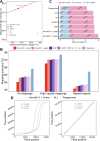Pangenome graph mitigates heterozygosity overestimation from mapping bias: a case study in Chinese indigenous pigs
- PMID: 40140905
- PMCID: PMC11948684
- DOI: 10.1186/s12915-025-02194-y
Pangenome graph mitigates heterozygosity overestimation from mapping bias: a case study in Chinese indigenous pigs
Abstract
Background: Breeds genetically distant from the reference genome often show considerable differences in DNA fragments, making it difficult to achieve accurate mappings. The genetic differences between pig reference genome (Sscrofa11.1) and Chinese indigenous pigs may lead to mapping bias and affect subsequent analyses.
Results: Our analysis revealed that pangenome exhibited superior mapping accuracy to the Sscrofa11.1, reducing false-positive mappings by 1.4% and erroneous mappings by 0.8%. Furthermore, the pangenome yielded more accurate genotypes of SNP (F1: 0.9660 vs. 0.9607) and INDEL (F1: 0.9226 vs. 0.9222) compared to Sscrofa11.1. In real sequencing data, the inconsistent SNPs called from the pangenome exhibited lower genome heterozygosity compared to those identified by the Sscrofa11.1, including observed heterozygosity and nucleotide diversity. The same reduction of heterozygosity overestimation was also found in the chicken pangenome.
Conclusions: This study quantifies the mapping bias of Sscrofa11.1 in Chinese indigenous pigs, demonstrating that mapping bias can lead to an overestimation of heterozygosity in Chinese indigenous pig breeds. The adoption of a pig pangenome mitigates this bias and provides a more accurate representation of genetic diversity in these populations.
Keywords: Genome graph; Mapping bias; Pangenome; Pig; Variant calling.
© 2025. The Author(s).
Conflict of interest statement
Declarations. Ethics approval and consent to participate: Not applicable. Consent for publication: Not applicable. Competing interests: The authors declare no competing interests.
Figures




Similar articles
-
Genome-wide genetic variation discovery in Chinese Taihu pig breeds using next generation sequencing.Anim Genet. 2017 Feb;48(1):38-47. doi: 10.1111/age.12465. Epub 2016 Jul 27. Anim Genet. 2017. PMID: 27461929 Free PMC article.
-
A genome-wide scan for signatures of selection in Chinese indigenous and commercial pig breeds.BMC Genet. 2014 Jan 15;15:7. doi: 10.1186/1471-2156-15-7. BMC Genet. 2014. PMID: 24422716 Free PMC article.
-
Genetic diversity and selection signatures of four indigenous pig breeds from eastern China.Anim Genet. 2022 Aug;53(4):506-509. doi: 10.1111/age.13208. Epub 2022 Apr 30. Anim Genet. 2022. PMID: 35489815
-
A survey of sequence-to-graph mapping algorithms in the pangenome era.Genome Biol. 2025 May 22;26(1):138. doi: 10.1186/s13059-025-03606-6. Genome Biol. 2025. PMID: 40405275 Free PMC article. Review.
-
Perspectives and opportunities in forensic human, animal, and plant integrative genomics in the Pangenome era.Forensic Sci Int. 2025 Feb;367:112370. doi: 10.1016/j.forsciint.2025.112370. Epub 2025 Jan 12. Forensic Sci Int. 2025. PMID: 39813779 Review.
References
Publication types
MeSH terms
LinkOut - more resources
Full Text Sources

